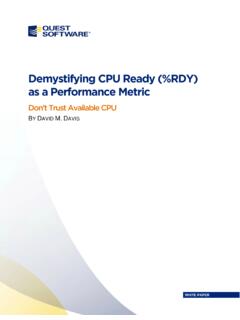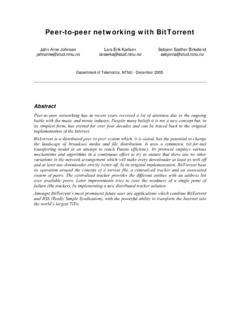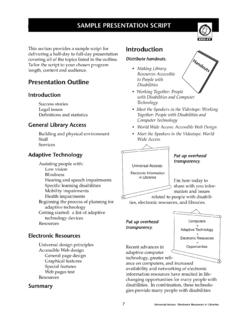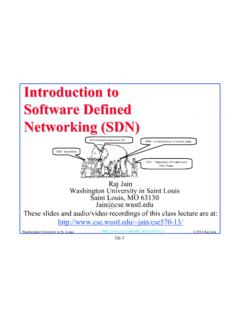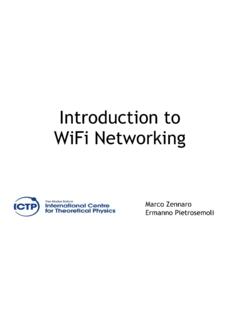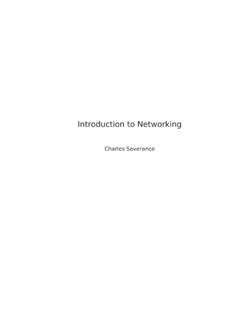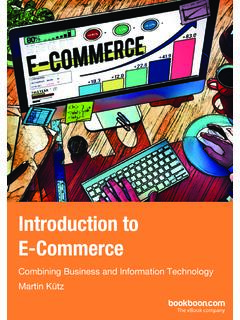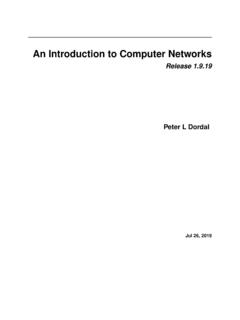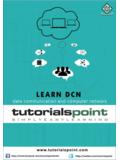Transcription of Linux Networking 101 - ActualTech Media
1 Linux Networking 101 Inside this Guide: Discover how Linux continues its march toward world domination Learn basic Linux administration tips See how easy it can be to build your entire network on a Linux foundation Find out how Cumulus Linux is your ticket to Networking freedom David M. Davis ActualTech Media Guide The Gorilla Helping You Navigate The Technology Jungle! In Partnership With The Gorilla Guide Linux Networking 101 Author David M. Davis, ActualTech Media Editors Hilary Kirchner, Dream Write Creative, LLC Christina Guthrie, Guthrie Writing & Editorial, LLC Madison Emery, Cumulus Networks Layout and Design Scott D. Lowe, ActualTech Media Copyright 2017 by ActualTech Media . All rights reserved. No portion of this book may be reproduced or used in any manner without the express written permission of the publisher except for the use of brief quotations.
2 The information provided within this eBook is for general informational purposes only. While we try to keep the information up-to-date and correct, there are no representations or warranties, express or implied, about the completeness, accuracy, reliability, suitability or availability with respect to the information, products, services, or related graphics contained in this book for any purpose. Any use of this information is at your own risk. ActualTech Media Okatie Village Ste 103-157 Bluffton, SC 29909 Entering the Jungle introduction : Six Reasons You Need to Learn Linux .. 7 1. Linux is the future .. 9 2. Linux is on everything .. 9 3. Linux is adaptable .. 10 4. Linux has a strong community and ecosystem .. 10 5. Linux is fun!.. 10 6. Linux is open-source and sometimes free .. 10 Chapter 1: What Is Linux ? .. 12 The History of Linux .. 13 What Is an Operating System?
3 14 The Components that Comprise the Linux Operating System .. 15 What Is a Distribution? .. 16 Understanding User Space vs. Kernel Space .. 16 Benefits of Using Linux .. 18 How Is Linux Used in the Enterprise? .. 21 Summary .. 22 Chapter 2: Basics of Linux 23 Where Do I Get Linux ? .. 23 How Do I Log In to Linux ?.. 24 How Do I Know What Type of Linux I Am Using? .. 26 Where Do I Find Things?.. 27 Where Are the Applications, and How Do I Run Them? .. 31 How Do I Install Applications? .. 33 Entering the Jungle iv Linux Processes, Programs, and Services .. 37 Importance of Linux Log Files .. 39 Users and Superusers .. 40 Files and Permissions .. 42 Summary .. 44 Chapter 3: Basics of Linux Network Administration .. 45 Understanding Linux Network Interfaces .. 45 MAC Addresses .. 48 IP 49 DHCP .. 51 DNS .. 53 Network Statistics and Counters .. 55 How to Configure Network Interfaces.
4 57 Network Interface Bonding .. 60 Summary .. 63 Chapter 4: Understanding Linux Internetworking .. 64 Layer 2 vs. Layer 3 Internetworking .. 66 Layer 2 Internetworking on Linux Systems .. 68 Bridging .. 68 Spanning Tree .. 70 Layer 3 Internetworking View on Linux Systems .. 73 Neighbor Table .. 73 IP Routing .. 74 Virtual LANs (VLANs) .. 76 Overlay Networks with VXLAN .. 79 Summary .. 82 Entering the Jungle v Chapter 5: Cumulus Linux .. 83 Network Command Line Utility (NCLU).. 85 Building a Better Bridge .. 87 Two Links Are Better Than One .. 88 IP Fabrics Are Easy .. 90 BGP EVPN L3 Network Virtualization for Network Engineers .. 92 Next Steps .. 95 Your Cumulus Linux Action Plan .. 95 Callouts Used in This Book The Gorilla is the professorial sort that enjoys helping people learn. In the Schoolhouse callout, you ll gain insight into topics that may be outside the main subject but that are still important.
5 This is a special place where readers can learn a bit more about ancillary topics presented in the book. When we have a great thought, we express them through a series of grunts in the Bright Idea section. Takes readers into the deep, dark depths of a particular topic. Icons Used in This Book Definition. Defines a word, phrase, or concept. Knowledge Check. Tests your knowledge of what you ve read. Pay attention. We want to make sure you see this! GPS. We ll help you navigate your knowledge to the right place. Watch out! Make sure you read this so you don t make a critical error! introduction Modern data centers are vastly different from legacy ones, and with good reason. In the past, companies typically supported a handful of critical monolithic applications, and the network was put in place primarily to support just those applications.
6 Once installed, the network was left mostly untouched in many organizations. It consisted of dedicated hardware-based routers and switches that, for the times, performed their tasks of routing and switching packets quite well. The routers and switches favored by many enterprises typically came from one of the big 3 Networking vendors, but their products generally included costly appliances made up of custom hardware and highly proprietary software. That network gear was so specialized that an entire ecosystem sprang up around it to provide training, education, certification, consulting, software and support maintenance, and more. Over time, the data center landscape has changed and for the better, particularly given that the application landscape has also morphed into something radically different from what was seen in the past.
7 The number of business-critical applications is on the rise, and, unlike their older stay-at-home cousins, modern applications are distributed between on-premises infrastructure, between partner networks, and across the public cloud. End user and company data moves around the globe at light speed, and it s happening constantly. New applications are being built today and torn down tomorrow in favor of even newer applications. Change is happening fast, and the network is adapting to support these changes. Thankfully, the specialized hardware that characterized legacy data centers isn t so necessary anymore. Today, Networking needs are being met using industry-standard switching/routing silicon, off-the-shelf hardware, Intel CPUs, and the Linux operating system. This introduction 9 combination makes Networking far more affordable, more scalable, easier to learn, and more adaptable to the constantly changing needs of the business.
8 After all, the network s sole purpose is to connect the users with their applications and data, so it should do it as reliably, securely, efficiently, and affordably as possible. The key piece of the previous paragraph and the focus of this book is this: Linux Networking is the future for almost every use case. But to leverage a Linux -based Networking solution, you need to understand Linux , and that s where this book comes in. Definitions Abound! If you don t know what some of these words mean, don t worry! We ll define them during your Linux 101 journey. By the end of this book, you ll be using these phrases in casual conversation! Six Reasons You Need to Learn Linux What if you don t know Linux and are asking yourself, Is this book really worth my time? The short answer is a resounding YES, but to back that up, let me give you six good reasons why you should invest some of your time to learn Linux .
9 1. Linux is the future Although Linux has been around for over 25 years, it has enjoyed a continuous rise in business-critical usage, and many see Linux as being the most popular operating system for the future. The reason as to why Linux is the lingua franca of the modern data center relates to the points below. 2. Linux is on everything Linux runs more than two-thirds of the servers on the Internet, all Android phones, most consumer network gear, such as NetGear and Linksys devices, 99% of the top supercomputers in the world, many Internet of Things (IoT) devices, Tesla cars, and even PlayStation gaming consoles. introduction 10 3. Linux is adaptable The very reason everything is on Linux is because it s such an adaptable operating system. Thanks to Linux s modularity and open-source nature, you can choose the pieces you need for your product or service and develop any pieces that may not already exist.
10 You can install tiny versions of Linux for specialized use cases (such as operating water sprinklers in the gorilla exhibit at the zoo), modify it to work on appliances that route packets across a large enterprise network, or use it as your desktop operating system. Your choices are practically endless. 4. Linux has a strong community and ecosystem Linux has been so successful mainly because of the strong community and ecosystem that surrounds it. There are Linux contributors (developers who write code to make the product better); Linux forums and communities; Linux instructors; Linux training options; Linux blogs; Linux third-party tools; Linux distributions; Linux conferences; and even Linux books such as this one! 5. Linux is fun! Linux is a lot of fun because you can do just about anything with it. Linux is commonly used in Internet of Things (IoT) projects; it runs on tiny Raspberry Pi computers commonly used by hobbyists, and it even makes a great operating system on your laptop or desktop computer.

